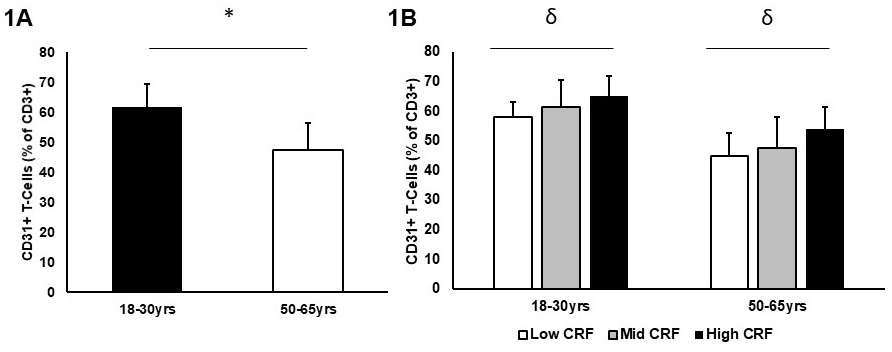CD31-expressing T-lymphocytes are highly vasculogenic T-lymphocyte subsets, with potential to stimulate angiogenesis and endothelial repair via paracrine means, including secretion of vascular endothelial growth factor (VEGF)1. Advancing age is associated with endothelial dysfunction, and subsequent cardiovascular disease risk2. Ageing results in altered T-lymphocyte composition due to infection history and antigen exposure3, and thus may also affect the CD31+ T-lymphocyte subset. A peripheral blood sample was taken from thirty-six young (18-30 years) and thirty-eight older (50-65 years) males and VO2max was measured using a graded exercise cycling test to exhaustion Peripheral blood mononuclear cells were isolated from peripheral blood samples, and incubated with monoclonal antibodies against CD3, CD31 and C-X-C Chemokine Receptor 4 (CXCR4). CD31+ T-lymphocytes were quantified as CD3+CD31+ cells using flow cytometry. Cell surface expression of CXCR4 of these CD31+ T-lymphocytes were also assessed using flow cytometry. Differences in CD31+ T-lymphocytes between age groups were assessed using independent-samples t-test. Subsequent analyses were performed to assess effect of VO2max on these cells in the two age groups using factorial analysis of variance (ANOVA), using age group and VO2max tertiles as factors in the analyses. Older adults exhibited lower CD31+ T-lymphocytes than younger adults (543 ± 229 cells/µL vs. 751± 236 cells/µL, p = 0.000), which is also reflected as lower proportion of CD3+ T-lymphocytes expressing CD31 (47.41 ± 8.99% vs. 61.67 ± 7.58%, p = 0.000). CXCR4 expression was significantly higher on CD31+ T-lymphocytes of older adults compared to younger adults (8.56 ± 1.18a.u vs. 12.91 ± 8.38a.u, p = 0.003). Young adults who displayed low VO2max displayed lower proportion of T-lymphocytes expressing CD31 than those with high VO2max (57.90 ± 5.15% vs. 65.06 ± 6.95%, p = 0.024), an observation observed in older adults (44.96 ± 7.86% vs. 53.85 ± 7.66%, p = 0.036). The number of CD31+ T-lymphocytes in the older high VO2max group was still significantly lower than the low VO2max young group (53.85 ± 7.66% vs. 57.90 ± 5.15%, p = 0.021). These data strongly indicate that advancing age results in lower number of angiogenic T-lymphocytes which may reflect endogenous vascular endothelial repair capacity, and thus elevating cardiovascular disease risk in older individuals. In addition, lower cardiorespiratory fitness in older people results in further reductions in CD31+ T-lymphocytes, suggesting that low cardiorespiratory fitness further exacerbates the age-related decline in these angiogenic cells.
Future Physiology 2019 (Liverpool, UK) (2019) Proc Physiol Soc 45, PC13
Poster Communications: Older Adults Display Lower CD31+ Circulating Angiogenic Cells, Which is Compounded by Low Cardiorespiratory Fitness
M. Ross1, R. Simpson2, E. Malone1, G. Florida-James1
1. School of Applied Science, Edinburgh Napier University, Edinburgh, United Kingdom. 2. UA College of Agriculture & Life Sciences; Dept. of Nutritional Sciences, University of Arizona, Tucson, Arizona, United States.
View other abstracts by:
Figure 1. A) CD31+ T-Lymphocytes in young and older adult men. B) Influence of cardiorespiratory fitness (CRF) on CD31+ T-Lymphocytes in 18-30 and 50-65yr old men. Values shown are mean ± SD. * p < 0.005 between young and older men, d p < 0.05 between low and high CRF groups.
Where applicable, experiments conform with Society ethical requirements.

